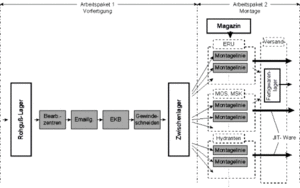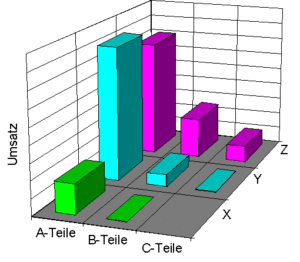Production logistics: process chain optimization at Erhard Armaturen
The storage of finished parts is extremely expensive, as almost the entire added value of the company, including personnel costs, is stored here. Erhard Armaturen GmbH & Co. has therefore optimized its entire procurement and production process in a two-year project in order to reduce the stock of finished goods and still increase delivery readiness. Today, up to 98% of the products are ready for delivery and stocks of finished goods are only held for products that have a high, predictable demand or that need to be available for installer customers who want to stock up on their way to work in the morning.
The reduction in finished goods also reduced the proportion of products that had to be dismantled or rebuilt due to missing parts. Overall, however, not only was the internal added value removed from the warehouse, but the entire stock of goods in the company was drastically reduced. As a result, inventories in the incoming and interim warehouses were reduced by around 40% despite a significant increase in delivery readiness. This led to a significantly improved financial structure for the company, because for every million DM in inventory value saved, 150 to 300 thousand DM in administrative costs can be saved.
Erhard Armaturen GmbH & Co is a company rich in tradition with currently 680 employees at 4 production sites in Heidenheim, Oettingen, Bad Köstritz and Daun and a turnover of DM 160 million. The Oettingen plant manufactures eight product groups in different variants for water and gas supply, wastewater disposal, industry and process engineering (e.g. metal-seated/soft-seated gate valves, non-return valves/check valves, air release valves, diaphragm valves, hydrants). Due to the wide range of variants, production is divided into prefabrication and several final assemblies (Fig. 1), which previously delivered to a finished goods warehouse.

Structure of just-in-time assembly
However, this finished goods warehouse was recognized as an unnecessary cost item and was to be reduced. In principle, this requirement is easy to fulfill: The warehouse is cleared step by step with the incoming orders until it is reduced to the right size and from then on only produces to order. This is of course a one-eyed view, as hardly any customer would accept the associated time delay of several weeks. As a result, the entire supply chain from purchasing to assembly had to be optimized (Fig. 2).

In order to be able to maintain at least the delivery readiness level at all times, the first step was to optimize the scheduling for the raw parts and semi-finished product warehouses and at the same time implement a production control system to set up assembly-synchronous prefabrication. This created the conditions for setting up just-in-time assembly and dismantling the finished goods warehouse.
Optimization of the disposition strategy
The article structure for each product group was determined and analyzed in order to define the replenishment strategy. The parts movements per product group from the interim warehouse/raw casting warehouse of the past financial year were used for this purpose. For the selection of suitable forecasting methods, it was necessary to know the fluctuations in demand per in-house production part and raw casting on a weekly basis. By means of an ABC-XYZ analysis (sales relevance-consumption behavior), the article structure per product group was assessed according to sales importance and predictability or uniformity of demand and the future stock development was calculated by means of simulation.
The findings from the analysis of the articles led to the determination of which semi-finished products need to be stored in the interim warehouse, which raw castings need to be stored in the raw casting warehouse and which forecasting methods are suitable for predicting future parts requirements. In addition, it was determined how batch sizes and minimum order quantities are to be determined in future and how the base value, safety stock and reorder point are to be calculated.
Assembly-synchronized production control
The objective of achieving flexible, responsive and cost-optimized production processes with high delivery readiness required the establishment of a “production control” organizational unit with the necessary expertise and responsibility. For this purpose, a load diagram was created for each machine by the scheduling and production departments from the stock receipts of the past financial year, thus revealing existing capacity bottlenecks. With this information, it was possible to set up capacity planning, which from now on will be managed on a rolling basis in weekly and monthly plans. Once the process and tools for managing customer orders had been defined, production planning was put into effect.
Structure of just-in-time assembly in three steps
The just-in-time assembly was then set up in three steps:
1. structuring of the product range
In order to be able to define future assembly lines, the range of end products was first analyzed in a preliminary study. For this purpose, the movements per product/product group of the past financial year were used for customer request dates and quantities and the requirements were determined in terms of amount and uniformity. These requirements were then submitted to the sales department for review with regard to future deviations for the coming years. The assembly process chains (including pre-assembly) for each product and product group were then recorded and the required capacity requirements per time unit were determined. The available capacity per product group was determined on the basis of these requirements.
2. material flow-oriented arrangement of the assembly lines
In order to determine a material flow-oriented arrangement of the assembly lines, a working team of production employees and consultants was appointed to collect suitable processing scenarios in a pilot project. The “hydrants” product group was particularly suitable for this, as it was assembled in a separate hall and new assembly lines could be tested without restrictions from other product groups.
First, the relevant criteria for the allocation of products to assembly lines were defined. This includes, for example, product subgroups, nominal widths, test specifications, required tools and test equipment as well as assembly and test times. The products were then distributed to the assembly lines. Two factors determined the material flow-oriented arrangement of the assembly lines:
- the hall layout specified, for example, available areas, hall doors, the general direction of material flow and stationary tools and equipment
- the range of parts to be provided (large/small parts, container sizes, storage options, etc). had to be dimensioned and arranged accordingly
In order to avoid intermediate buffers for pre-assembly units (assemblies), it was investigated how these could be integrated capacitively into the workflow of the assembly lines.
3. dimensioning of the staging buffers on the assembly lines
In order to be able to dimension the provision buffers appropriately, the range of parts required for each assembly line was determined using parts list resolution and classified according to the amount and uniformity of the parts required. Taking into account the dimensions of the parts, suitable containers and forms of provision (storage on site/ provision on demand) could now be determined. The required buffer areas were then determined and the arrangement of parts in the buffer determined. Due to the limited space available, some of these steps had to be carried out iteratively several times and adapted to the circumstances.
Finally, the replenishment strategy for parts from the purchased parts or in-house production parts warehouse was defined. Different strategies are used for parts stored on site: higher-value parts with regular requirements are restocked according to a Kanban system, bulk goods are replenished in regular cycles by a warehouse employee and pallet cages (mainly in-house production parts) are constantly checked by the responsible foremen due to the cramped conditions and made available at short notice by a forklift driver on request. Parts to be picked as required are put together on order and time-related picking trolleys and taken to a designated staging area.
Successful pilot project
The successful implementation of the pilot lines demonstrated the considerable potential of flexible JIT assembly and was able to largely eliminate the last skepticism of the employees. Following the positive experiences from the pilot project, the procedure described was transferred to all other product groups and a complete hall layout was then created.
The conversion of the entire production process was successfully completed in the second half of 2000:
- Finished goods inventories have largely been eliminated. Stocks are only required for the products that installers take with them on their way to work in the morning. The reduction in finished goods also reduced the proportion of products that had to be dismantled or rebuilt due to missing parts. Stocks in interim storage have also fallen by around 40% despite a significant increase in delivery readiness. The range of the interim storage facility for coated semi-finished products was less than one month, taking into account a safety stock.
- By using machining centers in the first processing stage, the raw casting will be processed in much smaller batches in the future. This led to a reduction of around 30% in incoming raw cast iron stock. As these parts are then fully machined directly in prefabrication, there is also no need for intermediate storage of pre-machined raw castings.
- In future, standard products can be delivered in three to five days thanks to the high flexibility of the assembly process. This corresponds to the regular delivery time requirements of many customers. In future, the entire production process will take around two weeks for EKB coating or three to four weeks for combined EKB and enamel coating.
The employees in the work team also view the new assembly organization very positively.

